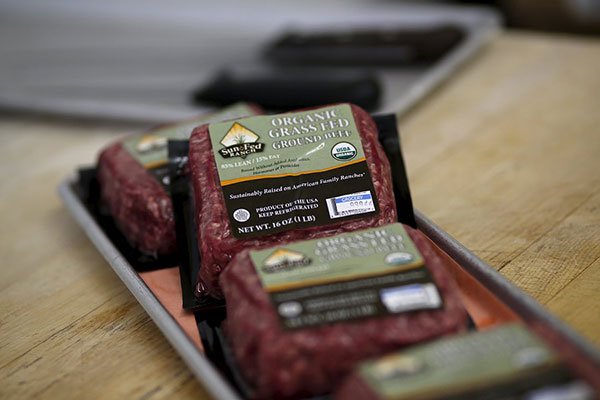US beef to be back on Chinese dining tables
 |
|
Individual packages of ground beef are shown with labels at a food market in San Francisco, California June 5, 2015. [Photo/VCG] |
US beef exports are set to resume as part of the Sino-US economic cooperation 100-day action plan unveiled in mid-May.
Chinese Vice-Finance Minister Zhu Guangyao disclosed that China plans to resume imports of US beef by July 16, exactly 100 days after Chinese President Xi Jinping met US President Donald Trump in Florida.
US Commerce Secretary Wilbur Ross and White House Press Secretary Sean Spicer welcomed the agreement at a news conference.
Meanwhile, Australia, China's top beef importer, is watching the beef market with great concern. Several Australian media outlets even reported plans to support industries related to beef export in the country.
Statistics showed that last year the gap between supply and demand in domestic beef market was 830,000 tons, which is expected to be filled as US beef re-enters the Chinese market.
Gao Guan, vice-secretary-general of the China Meat Association, told National Business Daily that price is one of the biggest competitive advantages of US beef.
Due to the low cost of raising cattle, the final retail price of US beef in China is still lower than domestically-produced beef even plus tariff and added-value tax. "No matter how the beef market changed, the biggest winner will be customers."
China banned US beef in 2003 after a case of bovine spongiform encephalopathy, or mad cow disease, in Washington state. Since the ban was introduced, China has experienced a beef boom.
Ministry of Agriculture data shows that 8 million tons of beef was consumed last year, with a market value of 360 billion yuan. In 2016, beef output rose 2.4 percent to 7.17 million tons from 7 million tons a year earlier. The gap between demand and supply was 830,000 tons.
China is filling the gap by increasing imports. Last year, 600,000 tons of beef was imported, a 22 percent increase from a year earlier.
China's enormous beef market has prompted Brazil and Australia to try to increase their market share amid fierce competition.
According to MIG Group, Brazil became China's biggest beef importer in January last year, with market share rising to 33 percent from 13 percent in 2015.
Australia is suffering from a drought that is hurting beef production. Last year, the export value of Australian beef to China fell 40 percent to A$670 million ($499 million).




















